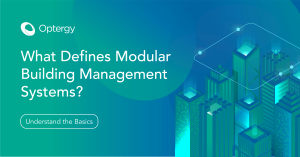What Defines Modular Building Management Systems?
The world of Building Management Systems (BMS) can be a labyrinthine landscape, where the term 'open system' often sparks confusion among consultants and end users.
While most grasp the concept of avoiding vendor lock-ins, the broader scope of open systems remains enigmatic. This article strives to bring clarity to these intricate topics, offering an unbiased exploration of BMS systems.

Historical Insights
To comprehend the current state of open systems in BMS, it is imperative to delve into their historical roots. In the past, BMS systems were typically closed and proprietary, with dominant players exercising exclusive control. However, substantial transformations occurred in the late 1990s and early 2000s when protocols began to open up, facilitating improved system communication. The true revolution unfolded in the 2000s with the emergence of open frameworks and the development of open protocols.
The Modern Landscape
Today, the BMS terrain has undergone a profound transformation. Contemporary BMS systems are characterized by modularity, where various components, including management systems, plant controls, terminal unit controls, and wireless sensing devices, can be interchanged like building blocks. These systems are built on vendor-neutral principles, relying on open standards and protocols for seamless interoperability.
Interoperability is the cornerstone of these systems, facilitated by widely accepted communication protocols such as BACnet, Modbus, and REST APIs. This ensures that components from diverse vendors can communicate effectively, liberating users from the constraints of a single vendor’s ecosystem.
Key Elements of Open and Multivendor Systems
Modularity
Open and multivendor systems are characterized by modularity, where different components of the system, such as management systems, plant controls, terminal unit controls, and wireless sensing devices, are designed to be interchangeable like building blocks. This modularity allows for the selection of the best-of-breed solutions for each specific function, rather than being tied to a single vendor’s ecosystem.
Vendor Neutrality
These systems promote vendor neutrality, meaning that they do not favour any particular vendor’s proprietary technology. Instead, they rely on open standards and protocols to ensure interoperability among various components from different vendors. This prevents vendor lock-in and allows for greater flexibility in choosing and switching components.
Interoperability
Interoperability is a fundamental aspect of open and multivendor systems. Components from different vendors should seamlessly communicate and work together. This interoperability is achieved through standardized communication protocols like BACnet, Modbus, or REST APIs, ensuring that all parts of the system can exchange data and commands effectively.
Flexibility
Open systems offer flexibility in terms of component selection and replacement. As technology evolves or the objectives of building owners/users change, individual components can be swapped out and replaced with alternatives without disrupting the entire system. This adaptability is crucial for the long-term sustainability of the building’s infrastructure.
Best-in-Class Approach
The Lego block approach allows for a best-in-class strategy, where each component can be chosen based on its merit and performance. This means that building owners and operators can select the most suitable solutions for their specific needs, resulting in a more efficient and effective overall system.
Scalability
Open and multivendor systems are scalable, accommodating the needs of buildings of different sizes and complexities. Whether it’s a small office or a large industrial facility, the system can be tailored by combining the right components to meet the specific requirements.
Cost-Efficiency
By avoiding vendor lock-in and selecting the best components for each function, open and multivendor systems can often lead to cost savings. Competition among vendors can drive down prices and improve the quality of components, ultimately benefiting the building owner.
Longevity
Open and multivendor systems are designed for the long term. They can adapt to changing technology trends and continue to meet the evolving needs of the building over its entire lifecycle, extending the value of the initial investment.
Conclusion
The BMS industry has embarked on a journey from the confines of proprietary systems to the liberating realm of open and modular systems. While proprietary systems had their merits in the past, modern BMS systems offer unparalleled flexibility, vendor neutrality, and adaptability. By understanding the nuances of these systems, consultants, building owners, and stakeholders can make informed decisions that align with current needs and future aspirations.
The essence lies in creating an ecosystem where the assembly of modular components mirrors the versatility and ease of building with bricks, and Lego blocks for smart buildings, ensuring that technology evolves harmoniously with the changing dynamics of the built environment.
Discover how Optergy can transform your BMS experience. Visit us now and take the first step towards a smarter, more efficient future.




